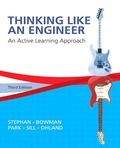
Concept explainers
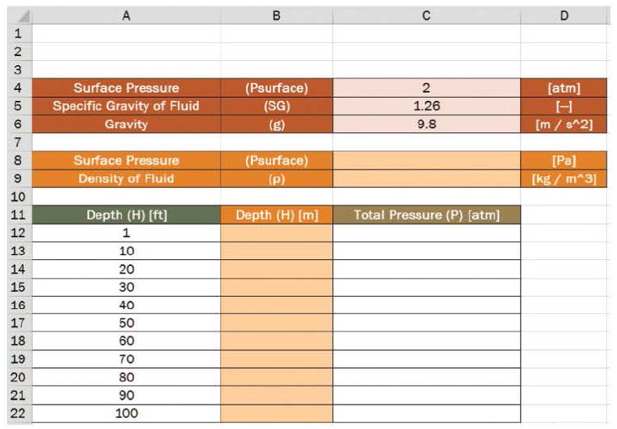 ICA 10-5
ICA 10-5
The worksheet shown here was designed to calculate the total pressure felt by an object submerged in a fluid as a function of the depth to which the object is submerged. The user will enter the surface pressure (in units of atmospheres), specific gravity of the fluid, and the gravity of the planet (in units of meters per second squared). All user input is shown in red. The worksheet will calculate the surface pressure in units of pascals, the density of the fluid in kilograms per cubic meter, and depth in units of feet. All conversions are shown in orange. Finally, the worksheet will calculate the total pressure in units of atmospheres.
- a. What formula should be typed in cell C8 to convert the surface pressure in cell C4 from atmospheres to pascals?
- b. What formula should be typed in cell C9 to determine the density in units of kilograms per cubic meter?
- c. What formula should be typed into cell B12 that can then be copied clown column B to convert the depth from units of feet to units of meters?
- d. What formula should be typed into cell C12 that can then be copied down column C to calculate the total pressure in units of atmospheres?
a.
Write the formula to be entered in cell C8 to convert the atmospheres surface pressure entered in cell C4 to Pascal.
Answer to Problem 1ICA
The formula to be entered in cell C8 to convert the atmospheres surface pressure entered in cell C4 to Pascal is “
Explanation of Solution
Given data:
The worksheet is given as follows.
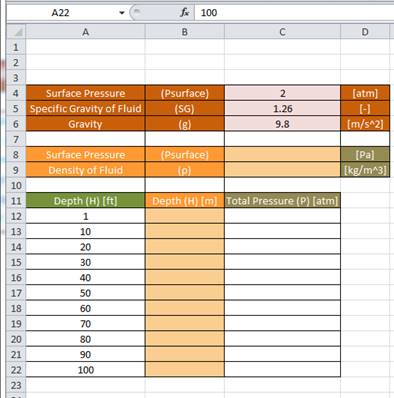
Calculation:
Consider the conversion factor for atmospheres to Pascal.
Step 1:
Using equation (1), enter the formula “

Conclusion:
Hence, the formula to be entered in cell C8 to convert the atmospheres surface pressure entered in cell C4 to Pascal is “
b.
Write the formula to be entered in cell C9 to determine the density in units of kilograms per cubic meter.
Answer to Problem 1ICA
The formula to be entered in cell C9 to determine the density in units of kilograms per cubic meter is “
Explanation of Solution
Calculation:
Write the expression for density.
Step 1:
Using equation (2), enter the formula “
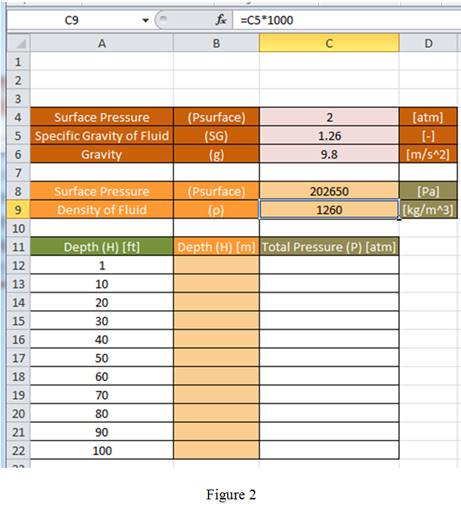
Conclusion:
Hence, the formula to be entered in cell C9 to determine the density in units of kilograms per cubic meter is “
c.
Write the formula to be entered in cell B12 that can be then be copied down column B to convert the depth in feet to meters.
Answer to Problem 1ICA
The formula to be entered in cell B12 that can be then be copied down column B to convert the depth in feet to meters is “
Explanation of Solution
Calculation:
Write the conversion factor for feet to meter.
Step 1:
Using equation (3), enter the formula “

Drag the same formula for remaining cells in the column to obtain the value of depth in terms of m as shown in Figure 4.
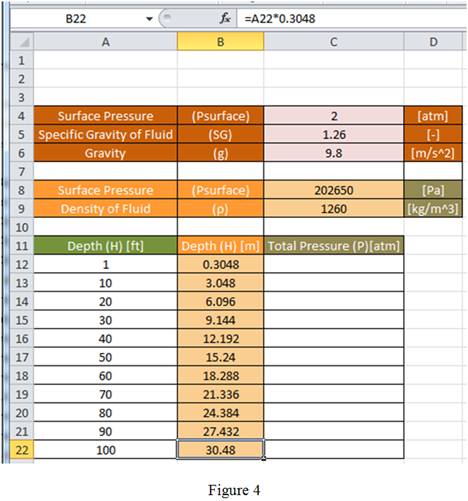
Conclusion:
Hence, the formula to be entered in cell B12 that can be then be copied down column B to convert the depth in feet to meters is “
d.
Write the formula to be entered in cell C12 that can be then be copied down column C to calculate the total pressure in atmospheres.
Answer to Problem 1ICA
The formula to be entered in cell C12 that can be then be copied down column C to calculate the total pressure in atmospheres is “
Explanation of Solution
Calculation:
Write the expression for total pressure.
Re-arrange equation (1) as follows.
Step 1:
Since, the content of cell C8 is in Pascal, the result obtained for total pressure using cell C8, C9, C6 and B12 is divided by 101,325 to convert the result from Pascal to atmosphere.
Using equation (4) and (5), enter the formula “
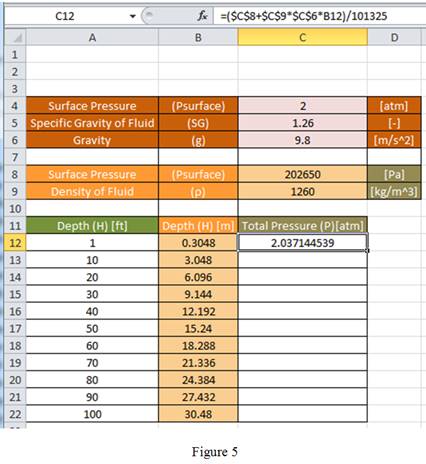
Drag the same formula for remaining cells in the column to obtain the total pressure value as shown in Figure 6.
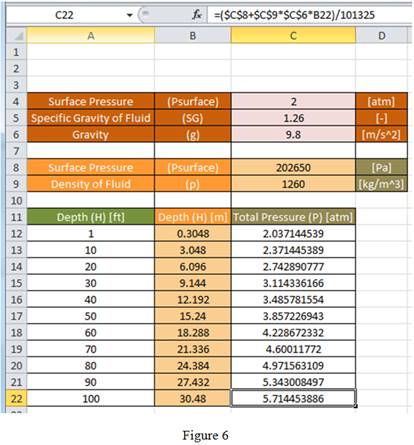
Since, the content of cell C4 is in atmosphere, the result obtained for
Using equation (4) and (5), enter the formula “
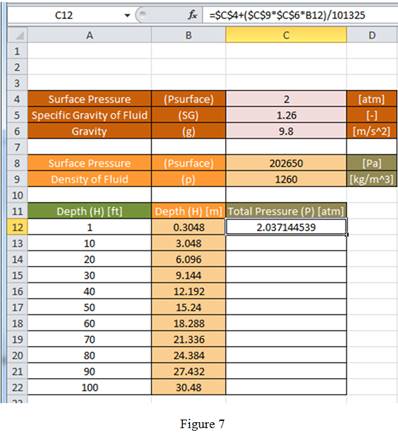
Drag the same formula for remaining cells in the column to obtain the total pressure value as shown in Figure 8.
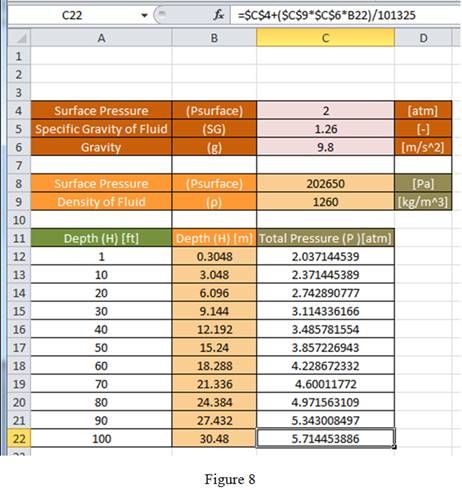
Compare Figure 5 with Figure 7 and Figure 6 with Figure 8, the result obtained for total pressure using formula
Conclusion:
Hence, the formula to be entered in cell C12 that can be then be copied down column C to calculate the total pressure in atmospheres is “
Want to see more full solutions like this?
Chapter 10 Solutions
Thinking Like an Engineer
Additional Engineering Textbook Solutions
Mechanics of Materials
Applied Fluid Mechanics (7th Edition)
EBK FUNDAMENTALS OF THERMODYNAMICS, ENH
Fundamentals of Aerodynamics
Fluid Mechanics Fundamentals And Applications
DeGarmo's Materials and Processes in Manufacturing
- Engineering Economy A company has determined the price and the monthly demand of its products are related by the equation D = √775 - p, where p is the price per unit in dollar and D, is the monthly demand. The associated fixed costs are $2,125 per month and the variable costs are $100/ unit. Use this information to answer the following: a)What is the optimal number of units that should be produced and sold each month? b) What is the maximum profit? c)Determine the value of D that represents the break-even point?arrow_forwardSuppose you're converting a bill of materials for machining feedstock from the British gravitational (U.S. system) of units to International System (SI) units. Your goal is to have all of the material quantities in kilograms. Your bill of materials lists values for required weights of brass rod in pounds. To convert to these values to kilograms you first you divide by gravitational acceleration in feet per second squared to get a mass in slugs, then convert slugs to kilograms using standard conversion factors. Group of answer choices True Falsearrow_forward2. (If relevant) A clearly labeled diagram (or diagrams) clearly pertaining to your analysis with a coordinate system and relevant labels. Final answer with appropriate units and significant figures. You can use the fprintf() command in MATLAB to format numerical results A 2-3 sentence reflection on your answer. Does it make sense? Why or why not? What are some implications?arrow_forward
- The amount of time it takes for a pendulum to swing “to-and-fro” through one complete cycle is called the “period” and is calculated using the following equation: where T = period in seconds, I = mass moment of inertia, m = mass of pendulum in kilograms g = gravitational acceleration, 9.8 m/s2, h = effective length of pendulum in meters What is the appropriate unit for I if the preceding equation is to be homogeneous in units? Please show all of your work.arrow_forwardA mercury thermometer, which has been on a table for some time, is registering the room temperature, 50°F. Suddenly, it is placed in a 395°F oil bath. The following data are obtained for the response of the thermometer. If after 10 seconds the thermometer reading is 176 F, determine the thermometer time constant. Round off the final ans to whole number Please show your complete solution and write readable.arrow_forwardThe Ideal gas law shows the relationship between some common properties of ideal gases and is written as PV = nRT. P = pressure, V = volume, n = number of moles of ideal Gas, R = General gas constant = 8.314 kJ/(kmol.K) and T = absolute temperature. 5 mol ideal gas at 22°C is placed in a cube with edge lengths of 0.750 meters. Calculate the pressure of the Ideal gas as [Pa].arrow_forward
- Seawater can be purified by distillation into potable water. If it costs 15 cents per kilowatt-hour for energy, what is the cost of energy to produce 100.0 gallons of drinking water at 100.0 ˚C if the seawater starts at 25.00 ˚C? (1 watt × 1 second = 1 joule). Enter your answer to the nearest penny.arrow_forwardTires are one of the most frequently encountered applications of the gas laws that we never think about. We fill our tires with air, or with nitrogen, but it always works out the same way. Enough gas goes in, the tire inflates, and then the pressure starts going up. In this assignment, we’ll be investigating the ways that the gas laws impact how we treat our tires. Q1. I have good information that in Fast 29, Dominic Toretto (Vin Diesel) will need to refill a tire quickly during a dramatic moment. For this reason, he has a 3.00 L tank of compressed air that is under 2.7892*103 mmHg and is kept cool in dry ice at -35.0 °C. When Dom hooks his compressed air up to his completely empty 10.50 L tire at 39.2 °C and lets it run, what will his final tire pressure be, in atm? Assume all the air is transferred into the tire. Is his tire pressure above the 2.31 atm that he needs to save the planet/his family/his crew? Q2. Your car tire pressure sensor looks to see when your tire pressure…arrow_forwardPLEASE SHOW SOLUION STEP BY STEP WITH UNITS. PLEASE ANSWER IT IN 30 MINS. TOPIC: THERMODYNAMICS - PROCESSES OF GASESarrow_forward
- Please provide equations that you are using so I can follow along and learn how to do this and include conversions and units. In Jamestown, NY, a coal power plan consumes coal at a rate of 80 tons/hr. When coal burns, it generates approximately 30,000 kJ for every kg of coal burned. The cooling course for the plant is the nearby Chadakoin River nearby and, by code, the power plant cannot reject more than 13.19 x 109 MJ into the river annually. Determine the maximum average power output of this plant and it's maximum thermal efficiency. To check your work, enter the efficiency, as a decimal, in the box provided.arrow_forwardAfter years of asking, you finally were allowed to go on a joy ride in your uncle’s 1956 Mercedes-Benz 300 SL. A notable feature of this vehicle is the gullwing door design that opens from a hinge at the top of the car. Unfortunately, you are having so much fun driving the car that you end up submerged in a fresh water lake. You sink to the bottom of the lake, which has a depth of 10 m. For the sake of simplicity, you can model the door as a 1 m × 1 m square plate, inclined at 45° relative to the floor of the lake. Neglect the weight of the door and friction in the hinge. How much force will be required to open the door, assuming you push from its geometric center?arrow_forwardThe title of our study is "Design and Fabrication of an Agricultural Spraying Attachment for an Autonomous Rover" we need help in the machine design part of our study, specifically Pump selection, battery selection, and center of gravity computation I already sent you the image of the rover Rover weight capacity 35 kilo grams (payload) Rover measurements: Wheel distance - 14.5 inches and 8.5 inches Rover platform size (width & length) 14.4 inches x 10.4 inches Height- 15.8 inches. Water tank selection More or less 25 liters *For tank selection we need to justify the size with the center of gravity, proving that is the maximum dimension or liters of the tank because the center of gravity will be higher making the rover prone to toppling Pump selection *Our sprayer design has two nozzles which splits using a tee splitter, we need to find the size of the pump to obtain the same discharge rate of a normal sprayer. A normal sprayer has a 12V pump and a pressure from 0.2 to 0.45 mpa…arrow_forward
 Elements Of ElectromagneticsMechanical EngineeringISBN:9780190698614Author:Sadiku, Matthew N. O.Publisher:Oxford University Press
Elements Of ElectromagneticsMechanical EngineeringISBN:9780190698614Author:Sadiku, Matthew N. O.Publisher:Oxford University Press Mechanics of Materials (10th Edition)Mechanical EngineeringISBN:9780134319650Author:Russell C. HibbelerPublisher:PEARSON
Mechanics of Materials (10th Edition)Mechanical EngineeringISBN:9780134319650Author:Russell C. HibbelerPublisher:PEARSON Thermodynamics: An Engineering ApproachMechanical EngineeringISBN:9781259822674Author:Yunus A. Cengel Dr., Michael A. BolesPublisher:McGraw-Hill Education
Thermodynamics: An Engineering ApproachMechanical EngineeringISBN:9781259822674Author:Yunus A. Cengel Dr., Michael A. BolesPublisher:McGraw-Hill Education Control Systems EngineeringMechanical EngineeringISBN:9781118170519Author:Norman S. NisePublisher:WILEY
Control Systems EngineeringMechanical EngineeringISBN:9781118170519Author:Norman S. NisePublisher:WILEY Mechanics of Materials (MindTap Course List)Mechanical EngineeringISBN:9781337093347Author:Barry J. Goodno, James M. GerePublisher:Cengage Learning
Mechanics of Materials (MindTap Course List)Mechanical EngineeringISBN:9781337093347Author:Barry J. Goodno, James M. GerePublisher:Cengage Learning Engineering Mechanics: StaticsMechanical EngineeringISBN:9781118807330Author:James L. Meriam, L. G. Kraige, J. N. BoltonPublisher:WILEY
Engineering Mechanics: StaticsMechanical EngineeringISBN:9781118807330Author:James L. Meriam, L. G. Kraige, J. N. BoltonPublisher:WILEY





